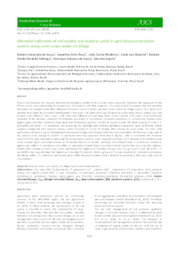Microbial indicators of soil quality and soybean yield in agricultural production system using cover crops under no-tillage.
Microbial indicators of soil quality and soybean yield in agricultural production system using cover crops under no-tillage.
Autoria: SOUSA, D. C. de; ROSA, J. D.; MEDEIROS, J. C.; BOECHAT, C. L.; NÓBREGA, R. S. A.; SOUZA, H. A. de; SAGRILO, E.
Resumo: Cover crops improve the physical, chemical and biological quality of the soil and boost crop yield. However, the magnitude of the effects on the microbial activity in tropical soils of Cerrado is still little explored. This study aimed to evaluate the soil microbial attributes and soybean yield after cultivation of cover crops in a sandy clay loam oxisol under no-tillage system, in a region with weather dominated by a bimodal rainfall pattern (Aw type). The experiment was designed in randomized blocks, using a split-plot scheme, with different cover crops in the plots and different soil sampling times in the subplots. The cover crops treatments consisted of the previous cultivation of Crotalaria spectabilis (C. spectabilis), Crotalaria ochroleuca (C. ochroleuca), Cajanus cajan (pigeon pea); Urochloa ruziziensis (brachiaria) and Pennisetum glaucum (millet) as monocrop and the intercropping of millet + C. spectabilis and millet + C. ochroleuca. Soil samplings for microbial and chemical attributes evaluations were performed before soybean sowing and after soybean harvest, which occurred at 12 and 18 months after sowing the cover crops. Dry mass (DM) productions of cover crops at full vegetative development stage and soybean yield were also estimated. All the cover crops used in the present study, except the millet + C. spectabilis intercrop produced more than 6 Mg ha-1, with is considered the minimum amount of dry mass indicated as adequate for conservation systems under tropical conditions. Soil cultivated with brachiaria and millet showed higher microbial biomass at 18 months than at 12 months. Similarly, soil cultivated with C. ochroleuca, brachiaria, pigeon pea, millet + C. ochroleuca and millet + C. spectabilis showed higher microbial N at 18 months than at 12 months. Eighteen months after sowing of cover crops, millet maintained the highest soil microbial biomass (161.24 µg C g soil-1) and the millet + C. spectabilis intercrop exhibited the highest soil microbial N contents (30.02 µg N g soil-1) across treatments. Crotalaria ochroleuca, brachiaria, millet + C. ochroleuca and monoculture millet increased soybean yield cultivated in succession, after one single cycle of crop rotation.
Ano de publicação: 2023
Tipo de publicação: Artigo de periódico
Unidade: Embrapa Meio-Norte
Palavras-chave: Biomassa, Conservação do Solo, Glycine Max, Microbial biomass, No-tillage, Plantio Direto, Soil quality
Observações
1 - Por padrão são exibidas publicações dos últimos 20 anos. Para encontrar publicações mais antigas, configure o filtro ano de publicação, colocando o ano a partir do qual você deseja encontrar publicações. O filtro está na coluna da esquerda na busca acima.
2 - Para ler algumas publicações da Embrapa (apenas as que estão em formato ePub), é necessário ter, no celular ou computador, um desses softwares gratuitos. Sistemas Android: Google Play Livros; IOS: iBooks; Windows e Linux: software Calibre.
Acesse outras publicações
Acesse a Base de Dados da Pesquisa Agropecuária (BDPA) para consultar o acervo completo das bibliotecas da Embrapa.

